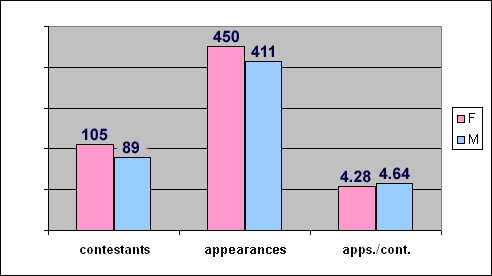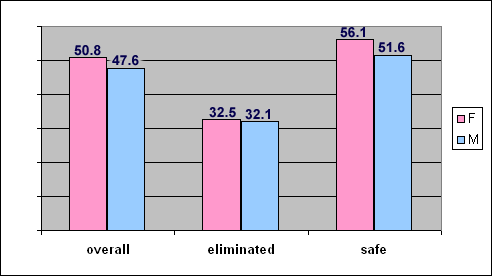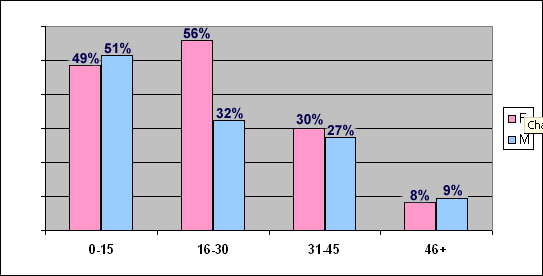Editorials and Articles Archive
It's a Man's Man's Man's World
What traits might help you succeed on Al? A Y chromosome is a good start.
18 January 2009
To kick off our 2009 series on Idolmetrics (the scientific study of success and failure on American Idol, as coined by our colleague Leo, The Idol Guy), what better way than to address a topic near and dear to everyone's heart: sex. Relax, we're not talking about Bikini Girl. Rather, we're going to answer one of the longstanding open questions surrounding Idol: all else being equal, is it more favorable to be a male or a female contestant on the show?
To put this in practical terms, let's bring out Ryan Seacrest to host another episode of Smile & Wave Night, as discussed in our Introduction to Idolmetrics. Our contestants this evening are twelve people you've never seen before in your life. Six are girls, six are guys, and aren't they all adorable? Okay, that's enough - now get to your phones and vote. No, you don't get to hear them sing; that would just complicate matters. The next night, after half an hour of insipid filler, Ryan opens the envelope to reveal which of these 12 strangers is going home. Place your bets: is it more likely to be a male or a female?
We sincerely hope you worked out the answer from the James Brown song we borrowed for the title. It's true: the men of AI have enjoyed a small but significant survival advantage over the years. How significant? Let's look at the data. If you'd prefer to look at Bikini Girl instead, go visit YouTube.
Where The Boys Are
(If you haven't done so already, please read the Perpetual Disclaimer that explains and covers all of our Idolmetric articles. All data below is drawn from AI1 through AI7.)
As far as we know, American Idol has never confirmed the ratio of women to men who audition for the show. Virtually everyone agrees, however, that the ladies form a substantial majority. Estimates we've seen on other websites suggest that it might be as high as two-to-one. Understandably, the producers aim for a more even balance when the main competition begins. Through the first seven seasons, there have been 105 female semifinalists and 89 males, a mix of roughly 54% to 46%.
How has the Battle Of The Sexes played out on AI? Let's define a contestant's appearances to be the number of episodes in which he or she performed, regardless of the number of songs sung. In other words, whether Kelly Clarkson gave one performance in a Top 32 show, or three performances in a Finale, each counts as one appearance. If guys and girls advanced with equal probability, we'd expect the ratio of their total appearances to remain 54-to-46. But as our first graphic shows, that hasn't exactly been the case.

While the ladies have still made more total appearances on American Idol, the ratio has narrowed a bit. Instead of 54-to-46, it's actually 52-to-48. So, broadly speaking, the typical guy lasts a little longer on the show than his distaff counterpart. The third column of numbers bears this out: On average, a male contestant makes 4.64 appearances, a member of the fairer sex, just 4.28.
Based on this information, let's calculate the Elimination Rate By Sex. That might sound like the title of the latest R-rated slasher flick at your local AMC, but bear with us. The Women of Idol thus far have made 450 total appearances on the show, and they've suffered 101 eliminations, making for a dismissal rate of 22.4%. The Men of Idol have made 413 appearances with 85 eliminations, for a rate of 20.6%....
...but hold on. It makes no sense to consider all-guy or all-girl episodes in our calculations, because someone of that sex had to be sent home one way or another. (For example, the last four episodes of Season Three had an abnormally high Female Elimination Rate, but that was because all of the guys had been kicked to the curb by then.) Taking into account only those episodes where at least one guy and one girl were in danger of forced retirement, we arrive at these final numbers:
Girls: 321 "risky" appearances, 74 dismissals, 23.1% Elimination Rate
Guys: 289 "risky" appearances, 59 dismissals, 20.4% Elimination Rate
In short, girls have gone home at a 2.7% faster rate so far. Chivalry, it seems, is dead on AI.
Who's Zoomin' Who?
Now, you may argue that 2.7% isn't all that big of a difference. It's not too far off the margin of error for the experiment, and besides, maybe all else hasn't been equal. Maybe the guys have just sung better than the girls.
Okay, smarty pants, let's check out that hypothesis. In theory, the average WNTS.com web approval rating is a 50. In practice, it fluctuates as new performances are added to the database, and it currently stands at 49.81. Here's a look at the relative ratings for the girls vs. the boys:

Maybe the guys have just sung better? Guess again. As the left column shows, it's the girls who have enjoyed a substantially higher average rating, by more than three full points! Yet, America sends them home at a faster clip.
The next two columns in the chart break down the numbers by voting results. For both men and women, the average farewell performance rates out around 32. But, you'll observe that a guy doesn't have to achieve quite as high of a rating as a girl to be safe: 51.6 to 56.1 on average.
Without going into gory detail, the historical difference in elimination rate between a 47.6 rating and a 50.8 rating is about 1.5%. In other words, if a contestant's sex had no bearing on the outcome, we would expect the girls of the first seven seasons to have advanced 1.5% more often than the guys, based on their respective average ratings. Instead, the guys advanced 2.7% more often. Thus, our first Idolmetrics conclusion of 2009 is as follows:
A male contestant on American Idol is approximately 4.2% more likely to advance safely to the next round than a female contestant, given comparable performances.
If 4.2% still doesn't sound like very much to you, keep in mind that we're talking about percentage rates per round. Like compound interest, this adds up over time. Say we started with a pool of 1000 men and 1000 women, and we eliminated the former at a rate of 20% per round and the latter at 24.2%. After three rounds, there would be 512 men still in the running, but only 436 women. After ten rounds, it would be 68 to 35. So yes, the guys' 4.2% advantage is quite significant given the length of the competition and the high stakes involved.
We'll leave it to others to debate the reasons behind this gender gap. (Our guess, and it's strictly that, is that the Idol electorate skews heavily young and female, and said group may be more predisposed to put their power-dialing hearts behind a cute guy than a cute girl.)
Of course, sex is just one non-performance factor that might play a role on American Idol. In upcoming weeks, we're going to look at age, race/ethnicity, and hometown region to see what effects they have, if any. In the meantime, you might want to contemplate this very scary footnote to the opening week episodes: now that the judges put a Bikini Girl through to Hollywood, can a Speedo Guy be far behind?
Addenda
Just for laughs, we calculated the male-to-female elimination rates by approval ratings, to see if anything interesting might turn up. Something did, as shown in Figure 3.

Note that the elimination rates were roughly the same for both sexes in three of the four ranges we studied. The only significant difference was in the 16-to-30 span, which might be thought of as "bad, but not a total train wreck", and the gap is eye-popping. It turns out that 34 of the 61 women who turned in a performance in that range were sent home, but only 22 of 68 men were! We're a little short on datapoints here to draw any firm conclusions, but perhaps this indicates that the average guy's fanbase is more willing to go to bat for them on an off-night.
One other interesting fact we discovered: through the first seven seasons, a female contestant is 50% more likely to wind up in the Bottom 2/Bottom 3 than a male one. The actual ratio is an astounding 96 to 64! The producers never release the actual vote totals, but it seems safe to assume that while the girls may have earned more accolades and praise for their singing in American Idol's first seven years, the guys have probably received more votes.
- The WNTS.com Team

